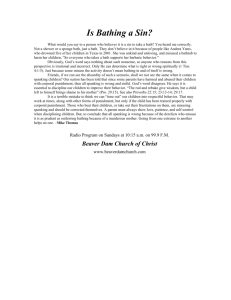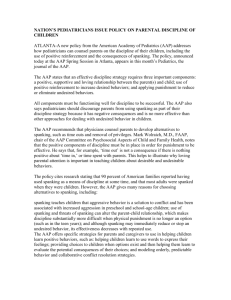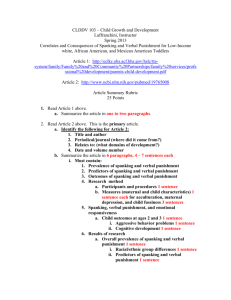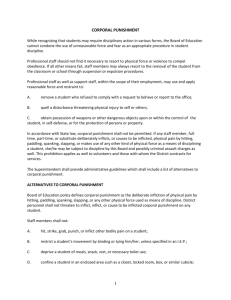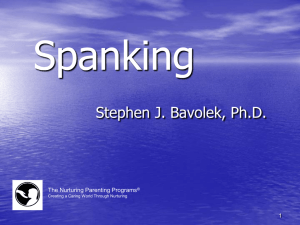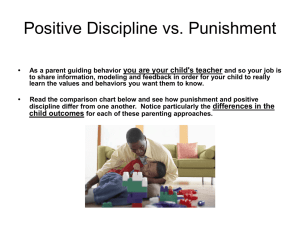Spanking 1 Paper #2: To Spank or Not to Spank 12145775 Anthony
advertisement
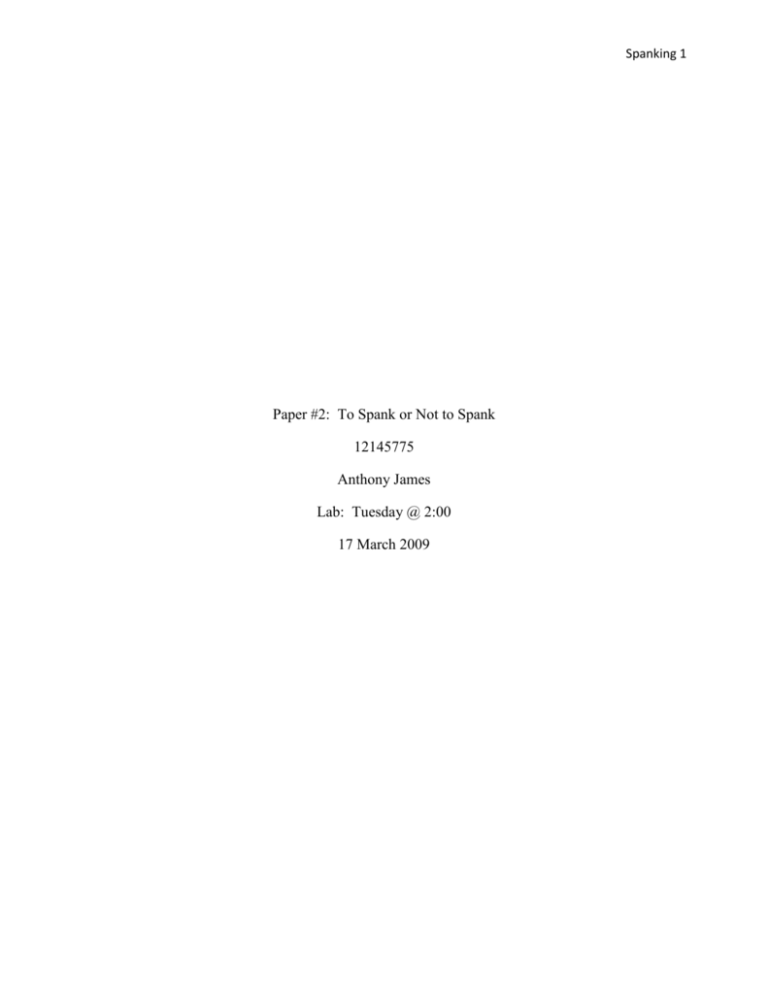
Spanking 1 Paper #2: To Spank or Not to Spank 12145775 Anthony James Lab: Tuesday @ 2:00 17 March 2009 Spanking 2 Introduction Spanking is a highly-debated discipline method that has been discussed by parents and professionals for many years, with strong feelings represented on both sides of the issue. There appears to be intense feelings that range from no spanking to moderate spanking when needed to regular spankings. The term spanking falls within the category of corporal punishment (CP) as a discipline method and will be referred to and interchangeable as such throughout this discussion. The goal of CP appears to be to change or alter behavior that parents find unacceptable. American parents across ethnic groups and socioeconomic levels accept the use of CP and believe that if used in moderation CP has no harmful effects (Dietz, 2000). Parents have reported that CP as a discipline technique is a necessary tool for some infractions (Dietz, 2000). Christian parents feel that CP is Biblical and accepted by God. However, more professionals are taking a stance against the use of CP as a discipline instrument. The American Academy of Pediatrics (1998) advices against CP and encourages pediatricians to educate their parents in alternative practices to discipline their children. Dr. Phil, you are interested in providing information about spanking or CP for the parents in your television audience and advice will be given. Psychological theories will be presented for the pros and cons of using CP as a tool of punishment. For this discussion, CP used on school aged children between the ages of 6 and 10 will be addressed. This particular age group is experiencing physical and emotional growth and observational learning is prevalent with parents having a great influence (Kail &Cavanaugh, 2007). Research will be presented on both the positive and negative effects of the argument for spanking with conclusions drawn so that you, Dr. Phil, will be clear as to my stance. Consequences of CP will be stated along with alternates to CP presented. Corporal punishment or spanking is a sensitive subject for parents and a challenging topic for professions. The important aspect of CP is whether or not it works. The effectiveness of Spanking 3 CP as a discipline method will be presented with valid research, and the effect of CP on children will be addressed. Culture and Frequency Dietz (2000) examined who was using CP and found mixed results among ethnic groups and differences among the socioeconomic levels. African American parents used physical punishment more often than European Americans and approved of CP especially with male children (Ispa & Halgunseth, 2004). Hispanic parents were less likely to use CP as a discipline tool (Ispa & Halgunseth, 2004). The occurrence of CP is greater within the southern United States and decreases as the child enters adolescence (Ispa & Halgunseth, 2004). Low-income parents used CP more often as did parents with less education, however, stress and overall violence were also more evident within that environment and may have a major impact on the use of CP (Dietz, 2000). The number of occurrences of CP varies from infrequent to occasionally to use only when other methods of discipline fail (Holden, 2002). Holden (2002) acknowledges that the recall of times parents used CP may be less than accurate due to faulty memory or definition of CP. It is evident that parents are using CP to discipline to some degree. Research on both sides of the practice has evidence supporting whether to use CP. Pros of Spanking Supporters of the use of CP state that spanking is used to reduce undesirable child behavior now and in the future. It may be used to make an impact on a child that is entering a dangerous situation suddenly (e.g. running into traffic, touching a hot stove). In this instance, parents believe spanking is performed out of love and concern rather than a punishment. David Benatar (1998) wrote extensively about this positive view of CP. He states that parents have the best interest of their children at heart and know their children better than anyone (Benatar, 1998). The message sent to children is clearly that if one does wrong they are punished and then only the guilty is Spanking 4 punished (Benatar, 1998). The argument supporting CP takes the position that parents have used spanking for years as a discipline tool and most children survived emotionally intact. According to advocates of spanking, current generations of children appear less respectful and could benefit from more CP. One group that agrees with Benatar’s reasoning in supporting CP is the conservative religious sector. They interpret the Book of Proverbs, chapter 23, verses 13 and 14 literally; part of which states: “Punish him [child] with the rod and save his soul from death”. They see CP as a quick way to correct bad behavior. Holden (2002) boasts another argument in favor of CP. He asserts that if such a large number of children are spanked then why is there such a small number of negative outcomes in such a large American population? According to Holden (2002) children that experience spanking may actually be more socially appropriate since America has relatively low crimes rates compared to other nations. Holden (2002) recommends changing the term of CP to customary physical punishment in order to be more accurate. He is also interested in whether or not the behavior ceased and if the behavior was ever repeated (Holden, 2002). Cons of Spanking Even though CP or spanking is commonly accepted, it appears to be a less effective strategy than other discipline tools. The Academy of Pediatrics (1998) discovered that CP resulted in agitated and aggressive behavior in children. Parent-child relationships are altered and because CP may relieve anger from the parent the practice may escalate (The Academy of Pediatrics, 1998). Gershoff (2002) found that the more CP experiences, the worse the behavior of the child. According to Gershoff (2002), CP on children led to increased aggression, antisocial behavior, reduced parent-child relationships, depression, alcoholism, low self-esteem and increases likelihood of becoming a victim of physical abuse later in life. Gershoff (2002) found that CP by its nature could escalate into physical maltreatment towards abuse. Walsh (2002) discovered that CP works Spanking 5 against what parents are trying to achieve by increasing aggression and maladaptive behaviors in children. Dupper and Montgomery-Dingus (2008) stated that CP is just not effective evidenced by the fact that the same children are spanked over and over again. They also found that children who experienced CP repeatedly showed lower abilities and decreased academic achievement. Since children 6-10 years of age model behavior, CP legitimizes the practice of violence by using aggression to solve problems (Dupper & Montgomery-Dingus, 2008). The National Association of Social Workers has taken a strong stance against CP and pronounced “the use of physical force against people, especially children is antithetical to the best values of a democratic society of the social work profession” (NASW, 2006). Simply stated, CP is not effective as a discipline tool. The behavior that a parent wants to stop may stop immediately but there is no evidence that the lesson is internalized and there appears to be no long term compliance (Gershoff, 2002). Corporal punishment or spanking is not effective as an obedience method and increases the occurrence of behavioral and emotional difficulties. Alternative discipline plans should be discussed with your audience as well as where to go for information regarding effective discipline strategies. Due to the negative effects of CP, I firmly recommend alternative methods of punishment. Conclusion As previously stated, my position is that the use of CP is not recommended for the discipline of children. My central argument is that based on the lack of effectiveness of CP. Parents continue to use CP with little results (Gershoff, 2002). The parent may be inflicting further harm on the child by using CP thus causing emotional and behavioral problems now and in the future. Children ages 6-10 learn by modeling and become physical with siblings and peers instead of learning to manage problems without violence. If CP was effective, in theory, less and less would be needed but CP is continuous within families. Spanking 6 Advice to Dr. Phil Based on this information, I will now provide advice. Dr. Phil, you have always asked this question when assessing situations and that is “How’s that working for you?” If parents are not receiving the results they desire then why do it? CP becomes a vicious cycle: parents spank their children, the children become angry adults, these adults then spank their own children. If hitting is seen as an acceptable way to deal with emotional situations then these children may become adults that hit a spouse or co-worker or even a boss. Alternative Discipline Techniques Some alternative discipline techniques may include time-outs, withdrawing privileges, or taking away toys or games. Educating students in health classes or parenting classes about alternatives can reduce the use of CP within this generation. Pediatricians could discuss and provide literature to parents about other ways to discipline their children. Discussing suggestions for good behavior may help. Many times stressed parents may forget the positives they see happening and forget to reinforce good behavior. Providing a few family rules that are simple and direct with consequences is quite helpful. If the goal of parents is to teach children to make good choices then education is the key to that end. If Christian parents are concerned about following guidelines from the Bible, share this with them “Train a child in the way he should go, and when he is old he will not turn from it.” from Proverbs 22:6. Training a child in mercy, forgiveness, and non violence follows the way in which Jesus lived. Fear and respect are not synonymous and superficial good behavior is not commendable behavior based on good values. Physical punishment gives the message that hitting is appropriate and problems can be solved with striking. Dr. Phil, tell your audience that gentle instruction based on love and respect is really the best way to discipline and mold their children. Spanking 7 References American Academy of Pediatrics. (1998). Guidance for Effective Discipline. The American Academy of Pediatrics Journal, 101, 723-728. Benatar, D. (1998). Corporal punishment. Social Theory & Practice, 24, 237-260. Committee on Human Rights. (2007). Concluding observations of the Committee on Human Rights: Zambia, 90th Sess., para. 22, U.N. Doc. CCPR/C/ZMB/CO/3/CRP. Dietz, T.L. (2000). Disciplining Children: Characteristics Associated with the Use of Corporal Punishment. Child Abuse & Neglect, 24, 1529-1542. Dupper, D.R., Montgomery- Dingus, A.E. (2008). Corporal Punishment in U.S. Public Schools: A Continuing challenge for School Social Workers. Children & Schools, 30, 243250. Gershoff, E.T. (2002). Corporal Punishment by Parents and Associated Child Behaviors and Experiences: A Meta-Analytic and Theoretical Review. Psychological Bulletin, 124, 519-579. Holden, G. W. (2002). Perspectives on the Effects of Corporal Punishment: Comment On Gershoff. Psychological Bullet, 128, 590-595). Ispa, J.M., Halgunseth, L.C. (2004). Talking about corporal punishment: nine low-income African American mothers’ perspectives. Early Childhood Research Quarterly, 19, 463-484. Kail, R.V., Cavanaugh, J.C. (2007). Human Development. Belmont, CA: Wadsworth. Lyons, Dr. John S., Anderson, Rachel L., and Larson, Dr. David B. "The Use and Effects of Physical Punishment in the Home: A Systematic Review." Presentation to the Section on Bio-Ethics of the American Academy of Pediatrics at annual meeting, Nov. 2, 1993. http://www.childprotectionreform.org/policy/spanking/spare_the_rod.htm. Spanking 8 National Association of Social Workers. (2006). Physical punishment of Children. In Social work speaks: National Association of Social Workers policy statements, 2006-2009 (7th ed., 290-295). Washington, DC: NASW press. Straus, M.A. (1994). Beating the devil out of them: Corporal punishment in American Families. New York: Lexington Books. Walsh, W. (2002). Spankers and Nonspankers: Where They Get Information on Spanking. Family Relations, 51, 81-88.
